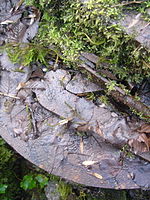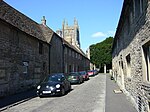The equestrian statue of Edward Horner stands inside St Andrew's Church in the village of Mells in Somerset, south-western England. It was designed by the architect Sir Edwin Lutyens, as a memorial to Edward Horner, who died of wounds in the First World War. The sculpture was executed by Sir Alfred Munnings.
Edward Horner was the only surviving son and heir of Sir John and Lady Frances Horner of Mells Manor and a member of an extended upper-class social group known as the Coterie, many of whom were killed in the war. The group included Diana Manners who Edward pursued unsuccessfully for several years, his future brother-in-law - Raymond Asquith Julian Grenfell, Patrick Shaw-Stewart and Charles Lister. Shortly after the war broke out, he was a yeomanry officer in the part-time Territorial Force but he was keen to join the fighting on the Western Front and obtained a transfer to a cavalry regiment through his family's connections. He was wounded in May 1915, losing a kidney, and did not return to the war until early 1917. He was assigned a staff post but again secured a transfer to the front line. Shortly after his return to the fighting, on 21 November 1917, he was wounded again; he died the same day.
Lutyens was a friend of the Horner family, having designed multiple buildings and structures for them since the beginning of the 20th century. As well as Horner's memorial, he designed a memorial to Raymond Asquith (also in St Andrew's Church), and Mells War Memorial in the centre of the village. For Horner's memorial, Lutyens designed the plinth himself, and engaged the renowned equestrian painter and war artist Alfred Munnings for the latter's first public work of sculpture. The plinth is in Portland stone and set into it is Horner's original grave marker; the family's coat of arms is carved into the front, while the sides bear various dedicatory inscriptions. The statue is a bronze of a cavalry officer on horseback, bare-headed, with his helmet and sword on the horse's saddle. Lutyens was known for abstract and ecumenical themes in his war memorial designs, but the statue of Horner is an example of his use of more conventional imagery to commemorate an individual. Installed in the Horner family chapel in St Andrew's Church in 1920 at a cost of £1,000, it was moved to its present location in the church in 2007.












